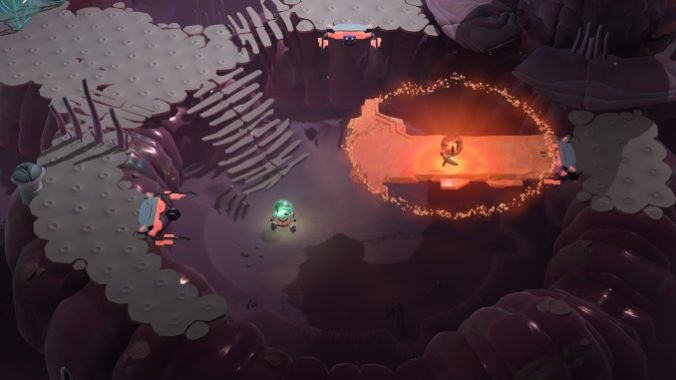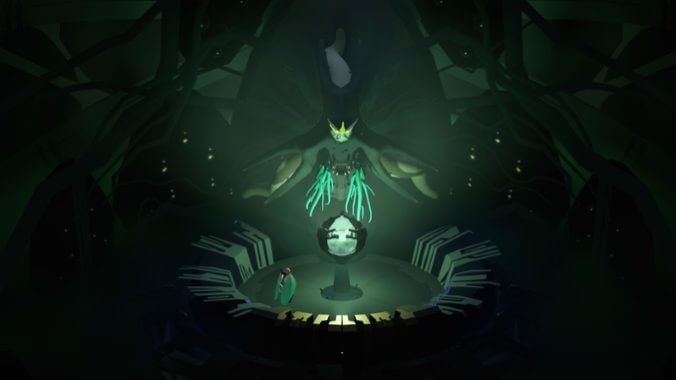Coming away from this year’s Summer Game Fest, there was a clear winner in the hearts and minds of most folks I talked to: Cocoon, the new game from Jeppe Carlsen, the lead gameplay designer on both LIMBO and INSIDE. Its eerie alien atmosphere, superb animation, and mind-bending recursive world mechanic just about blew everyone’s mind—myself included—and left me itching to dive further into its curious worlds. Having now played a significant chunk of the game, I can say without a doubt that Cocoon is an immensely gratifying, otherworldly, and singular experience.
Beginning in a desert biome, you play as an insectoid with a penchant for puzzles rather than words, much like Carlsen’s previous work and the games they inspired. Wordlessly, the world communicates everything you need to get by in a simplistic and elegant way. Holding down one of the face buttons touches your wings to the ground, which when done above certain insignias in the ground can activate structures, catapults, switches and the like. Oftentimes, you will be carrying a colored orb (in my time they have been orange, green and purple) that contain whole worlds within them and using them as batteries of sorts as you navigate the environment’s endlessly clever puzzles. Each is tied to a different power that’s only active when you’re carrying them, like the orange orb’s ability to render invisible walkways visible or the green orb’s ability to make certain structures lose or gain solidity. At first, the puzzles are pedestrian, asking you to ferry one orb to certain spots where you can anchor them, open a reflective pool and jump into the world within—a motion that happens in a seamless and exhilarating animation no matter how many times I’ve seen it.

The real complexity and fun of Cocoon comes in how you make these worlds and orbs talk with each other. You can bring these worlds into one another, rendering the orbs into a cosmological nesting doll that makes it simpler to carry from Point A to Point B. This is often the move as the worlds you traverse, like the green orb’s wetlands or the purple orb’s innards, became increasingly complex with security measures. These run the gamut from simple bars that make it hard to pass with an orb on your back to fly traps that capture a drone you can occasionally free to lower barricades and activate gates on the critical path. Sometimes the answer will simply be a kinetic puzzle, though, where you drop an orb into a chute and have to race to a switch that changes part of the chute’s track in order to make it get to where it needs to go.
Like LIMBO, but especially INSIDE, the mechanics continue to layer even further the deeper you wade into Cocoon, asking you to seamlessly execute multiple of these functions in a fell swoop. It’s never belabored, thanks to the player character’s agility and nimbleness, which especially come in handy in the game’s select boss encounters. By my estimation, every zone has one big bad to take on in fights that give the orbs you’re used to carrying unique properties. In one of them, I had to drive the boss into one of several columns, which would then reveal the orb I needed. Once I snagged it and pulled, a stream of water would propel me into the air where I would then glide between waves of projectiles until the boss finally rested, allowing me to plunge the orb like I was making a bombing run. In another, I could warp parallel to my position in the arena to knock a projectile into the boss, peeling at its layers as it picked up in intensity, speed, and even terraformed the stage. You can get knocked out of these fights in one hit, but luckily they are all three-cycle fights that you can run right back into within about 10 seconds. By the by, though they aren’t the most demanding encounters in the world, they’ve been an excellent way to break up the puzzle-solving and quiet ambience of Cocoon‘s many layers.
At the end of the day, what I value most about Cocoon, which is firing on all cylinders as I barrel towards the ending, is the way in which it trusts me. It provides just enough in the construction of its world to guide me to what I need to do without ever explicitly telling me how to. There’s no nagging voice telling me what to do, no glimmer on certain objects to key me into a clue. It’s not a puzzler made to the standards of the obtuse forefathers of the genre, nor the cloying helpfulness of puzzles in your present run-of-the-mill adventure game. It enjoys its mysteries, keeping the player at just the right length to have to work for an answer, and it’s successfully held my attention and favor all along.
Moises Taveras is the assistant games editor for Paste Magazine. He was that one kid who was really excited about Google+ and is still sad about how that turned out.

